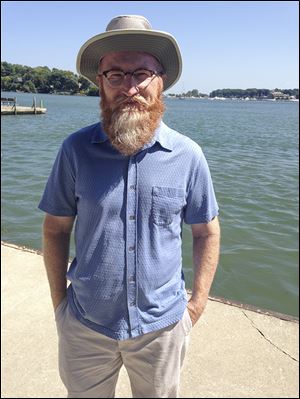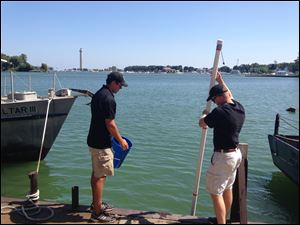
Scientists look for sweet spot in algae research with 'The Scum Project'
8/28/2018
Sunrise on Gibraltar Island.
THE BLADE/TOM HENRY
Buy This Image
GIBRALTAR ISLAND, Ohio — Scientists have a seemingly endless supply of papers chock full of arcane words that many of us mortals dismiss as gobbledygook because they are so technical and hard to understand.
Not so with a new initiative in western Lake Erie algal blooms, which speaks the language ordinary people can understand with this title: The Scum Project.
The concept was unveiled near the end of an annual two-day science writers workshop at Ohio State University’s Stone Laboratory on Gibraltar Island by University of Toledo algae researcher Tom Bridgeman, one of the event’s many speakers.

University of Toledo algae researcher and UT Lake Erie Center Director Tom Bridgeman.
Mr. Bridgeman, who recently became director of UT’s Lake Erie Center, said the Scum Project is a collective rethinking among several scientists over how they can best serve the public with their algal bloom research. It’s an effort to find the sweet spot between biomass and toxins.
NASA, for example, is getting much higher definition images of western Lake Erie algae blooms from outer space, thanks to a next-generation satellite launched April 25 by the European Space Agency. Another is planned for launch in 2019.
But even though the advanced digital technology is now capable of generating razor-sharp images deep below Lake Erie’s surface and is among the region’s most sophisticated, high-tech, and important research tools, it has its limitations — namely, an inability to detect toxicity.
“A satellite can only see what you see,” Mr. Bridgeman said.
Chasing toxins requires field scientists to pull water samples and have them analyzed in laboratories.
WATCH: Scientists test algae blooms in Lake Erie
“But you can only do boat-based measurements here and there. You can't cover the whole lake. It's a very spotty measurement. And there are other toxins in the lake we need to be screening for. There’s more than microcystin out there,” Mr. Bridgeman said, referring to the toxin produced by the lake’s dominant form of harmful blue-green algae, microcystis, which — at 3.5 billion years old — is one of Earth’s oldest-living organisms.
Microcystis is genetically a bacteria and is called a cyanobacteria because of its bluish-green hue.
So is it better to track toxins or biomass? For public drinking water, it’s obvious the former takes precedence. But charter boat fish captains and others engaged in Ohio’s $15.1 billion lake-based tourism and recreation economy certainly don’t want to dismiss biomass, nor would real estate agents hoping to keep up property values.
“I would say that we know that cyano scums can interfere with our ability to accurately measure HABs [harmful algal blooms], but we don’t know how much of a problem it is,” Mr. Bridgeman said. “Our project will measure how severely scums affect our HAB measurements and will develop methods for correcting scums.”

Justin Chaffin with an integrated tube unit used to pull water samples.
Scums are generally defined as concentrations of algae particles so dense they form mats on the lake surface.
Also during the workshop’s second day, Amy Klei, chief of the Ohio Environmental Protection Agency’s drinking and ground water division, said microcystins are the most prevalent waterborne toxin statewide, now detected in 43 of Ohio’s 120 public water systems that rely on surface water as their primary source. Saxitoxins are in 12 public water systems, she said.
“The public is more aware of its drinking water,” she said. This is post-Toledo and post-Flint. To me, it poses challenges and opportunities.”
Suzanne Gray, an assistant OSU professor and physiological ecologist, said freshwater systems such as Lake Erie are the “most threatened ecosystems on the planet” because of intensive human impacts and climate change. She said the impacts include dredging, shoreline development, invasive species, runoff, wetlands losses, and habitat destruction — all of which combine to make a fish’s life harder than in years past.
“Across the world, these are some major stressors fish have to deal with on a daily basis,” she said, adding they have proven to be remarkably adaptive so far.
But amphibians aren’t so lucky.
“There are fewer frogs than there used to be,” Ms. Gray said. “We’re losing an entire species.”
Her research shows, among other things, that fish lose more visibility in algae-infested water than water that is turbid from suspended sediment, potentially affecting their ability to forage for food and fend off predators.
In laboratory tests, she has tracked fish eye movement and attention span by a rotating drum with black and white stripes around their tanks at various speeds. The fish tracked the images well during slow rotations, but became inattentive when speeds were increased and stripes became more of a blur.
Ms. Gray said she found walleye had a 40 percent vision reduction in greenish algae water compared with similar densities of brownish sediment water, suggesting they are sensitive to colors and algae’s ability to block more light. One of their favorite prey, emerald shiners, fared slightly worse, with 43 percent less vision in algae than in water turbid from sedimentation.
Contact Tom Henry at thenry@theblade.com, 419-724-6079, or via Twitter @ecowriterohio.